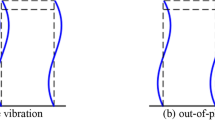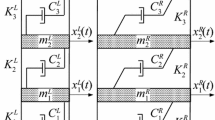Abstract
A seismic pounding occurs if there is not enough distance between nearby buildings to allow their relative movements during earthquakes. The most simple and effective method to reduce pounding and prevent damage from pounding is to establish a suitable separation distance, but it can be difficult to achieve because of the expensive land cost. The solution to eliminating the pounding between buildings is to use stiffeners to reduce the impact of pounding by reducing lateral displacements like R.C. walls and bracings or enhancing the behavior of the structure by utilizing seismic energy dissipation techniques. Previous techniques have some difficulties when applied especially in existing buildings, therefore, this research aims to study the use of a new technique that proposes to link the two adjacent buildings by link beams and to investigate the best location of these links. Three cases were selected to study pounding mitigation techniques between two nearby buildings. For each case, three main locations were selected to link the two nearby buildings on the first, middle, and last floors of the short building. The results of the study indicate that pounding force decreases when two buildings are connected on the first and middle floors in all cases studied. The percentage of decrease in pounding force ranges between 40–50 and 70–80%, respectively. While pounding eliminates when two buildings are connected on the last floor of the shorter building in all cases studied.






















Similar content being viewed by others
Data availability
All data generated or analysed during this study are included in this published article.
References
Abdeddaim, M., Ounis, A., Djedoui, N., & Shrimali, M. (2016). Reduction of pounding between buildings using fuzzy controller. Asian Journal of Civil Engineering, 17(7), 985–1005.
Abdel, R., & Shehata, E. (2006). Seismic Pounding between Adjacent Building Structures. Electronic Journal of Structural Engineering, 6(1), 66–74.
Abdel Raheem, R. (2014). Mitigation measures for earthquake induced pounding effects on seismic performance of adjacent buildings. Bulletin of Earthquake Engineering, 12(4), 1705–1724.
Alama, M. S., & Masmoum, M. S. (2020). Tying Devices to Mitigate Pounding of Adjacent Building Blocks. Engineering, Technology & Applied Science Research, 10(3), 5643–5647.
Anagnostopoulos, S. A. (1988). Pounding of buildings in series during earthquakes. Earthquake Engineering and Structural Dynamics, 16(3), 443–456. https://doi.org/10.1002/eqe.4290160311
Barros, R. C., Naderpour, H., Khatami, S. M., & Jankowski, R. (2016). Numerical study on pounding between two adjacent buildings under earthquake excitation. Shock and Vibration, 2016(4), 1–9. https://doi.org/10.1155/2016/1504783
Bhaskararao, A.V. and Jangid, R.S. (2004). Seismic response of adjacent buildings connected with dampers. In: 13th World conference on earthquake engineering. Canada: Vancouver, B.C., Paper No. 3143.
Cole, G. L., Dhakal, R. P., & Tuner, F. M. (2012). Building pounding damages observed in the Chrischurch earthquake. Earthquake Engineering and Structural Dynamics, 41(5), 893–913.
Collins, R. G., & Bertero, V. V. (1973). Investigation of the failure of the Olive View stair towers during the San Fernando earthquake and their implications on seismic design, EERC Report No. 73–26. Berkeley: University of California, Earthquake Engineering Research Center.
Eren, U. Z., & Muhammad, N. S. (2009). Dynamic analysis of adjacent buildings connected by fluid viscous dampers. Earthquake Resistant Engineering Structures, WIT Transaction on the Built Environment, 104, 139–150.
Favvata, M. J. (2017). Minimum required separation gap for adjacent RC frames with potential inter-story seismic pounding. Engineering Structures, 152(1), 643–659. https://doi.org/10.1016/j.engstruct.2017.09.025
Favvata, M. J., & Karayannis, C. G. (2005). Earthquake-induced interaction between adjacent reinforced concrete structures with non-equal heights. Earthquake Engineering Structural Dynamics, 34(1), 1–20.
Geetopriyo, R., & Pallab, D. (2018). Noble methods to Prevent pounding between Adjacent Buildings. Journal of mechanics of continua and mathematical sciences, 13(4), 134–146. https://doi.org/10.26782/jmcms.2018.10.00012
Gutub, S., & Mahmoud, S. (2013). Earthquake induced pounding-involved response of base-isolated buildings incorporating soil flexibility. Advances in Structural Engineering, 16(12), 71–90.
Hytham, E., Robert, J., & Ayman, S. (2021). Mitigating the seismic pounding of multi-story buildings in series by linear and nonlinear fluid viscous dampers. Archives of Civil and Mechanical Engineering, 21(4), 1–16. https://doi.org/10.1007/s43452-021-00249-9
Jankowski, R. (2007). Theoretical and experimental assessment of parameters for the non-linear viscoelastic model of structural pounding. Journal of Theoretical and Applied Mechanics, 45(4), 931–942.
Jankowski, R., & Mahmoud, S. (2011). Modified linear viscoelastic model of earthquake-induced structural pounding. Iranian Journal of Science and Technology, 35(1), 51–62.
Jankowski, R., & Mahmoud, S. (2016). Linking of adjacent three-story buildings for mitigation of structural pounding during earthquakes. Bulletin of Earthquake Engineering, 14(11), 3075–3097. https://doi.org/10.1007/s10518-016-9946-z
Jankowski, R., & Sołtysik, B. (2013). Non-linear strain rate analysis of earthquake-induced pounding between steel buildings. International Journal of Earth Sciences and Engineering, 6(3), 429–433.
Kamel, T. K. (2023). Estimating the Seismic Pounding Force between Adjacent Buildings and Study the Effect of Gap Distance on Seismic Pounding. Asian Journal of Civil Engineering, 24(1), 153–167.
Karabork, T., & Aydin, E. (2019). Optimum design of viscous dampers to prevent pounding of adjacent structures. Earthquakes and Structures, 16(4), 437–453. https://doi.org/10.12989/eas.2019.16.4.437
Karamaneas, C. E., & Anagnostopoulos, S. A. (2008). Use of collision shear walls to minimize seismic separation and to protect adjacent buildings from collapse due to earthquake-induced pounding. Earthquake Engineering Structural Dynamics, 37(12), 1371–1388. https://doi.org/10.1002/eqe.817
Kasai, K., Jeng, V., & Maison, B. F. (1992b). A spectral difference method to estimate building separations to avoid pounding. Earthquake Spectra, 8(2), 201–223.
Kasai, K., Jeng, V., Patel, P. C., Munshi, J. A., & Maison, B. F. (1992). Seismic pounding effects-survey and analysis. Proceedings of the 10th world conference on Earthquake engineering, 7, 3893–3898.
Kasai, K., & Maison, B. F. (1997). Building pounding damage during the 1989 Loma Prieta earthquake. Engineering Structures, 19(3), 195–207.
Komodromos, P. (2008). Simulation of the earthquake-induced pounding of seismically isolated buildings. Computers and Structures, 86(7), 618–626.
Komodromos, P., & Polycarpou, P. C. (2010). Earthquake-induced poundings of a seismically isolated building with adjacent structures. Engineering Structures, 32(7), 1937–1951. https://doi.org/10.1016/j.engstruct.2010.03.011
Lopez, G.L. (2004). Separation between adjacent nonlinear structures for prevention of seismic pounding. In: 13th world conference on earthquake engineering, Vancouver, Canada.
Maison, B. F., & Kasai, K. (1992). Dynamics of pounding when two buildings collide. Earthquake Engineering Structural Dynamics, 21(9), 771–786.
Meli, R., & Rosenblueth, E. (1986). The 1985 earthquake: Causes and effects in Mexico City, Concrete International Magazine. American Concrete Institute (ACI), 8(1), 23–34.
Miari, M., Choong, K. K., & Jankowski, R. (2019). Seismic pounding between adjacent buildings: Identification of parameters, soil interaction issues and mitigation measures. Soil Dynamics and Earthquake Engineering, 121, 135–150.
Miari, M., Choong, K. K., & Jankowski, R. (2021). Seismic pounding between bridge segments: A state-of-the-art review. Archives of Computational Methods in Engineering, 28, 495–504.
Naderpour, H., Naji, N., Burkacki, D., & Jankowski, R. (2019). Seismic response of high-rise buildings equipped with base isolation and non-traditional tuned mass dampers. Applied Sciences, 9(6), 1–22. https://doi.org/10.3390/app9061201
Patel, C. C., & Jangid, R. S. (2014). Dynamic response of identical adjacent structures connected by viscous damper. Structural Control Health Monitoring, 21(2), 205–224. https://doi.org/10.1002/stc.1566
Penzien, J. (1997). Evaluation of building separation distance required to prevent pounding during strong earthquakes. Earthquake Engineering Structural Dynamics, 26(8), 849–858.
Pratesi, F., Sorace, S., & Terenzi, G. (2014). Analysis and mitigation of seismic pounding of a slender R/C bell tower. Engineering Structures, 71(1), 23–34. https://doi.org/10.1016/j.engstruct.2014.04.006
Qiang, X., Jianyun, C., & Jing, L. (1999). Dynamic Response of Damper-Connected Adjacent Buildings under Earthquake Excitation. Engineering Structures, 21(1), 135–148. https://doi.org/10.1016/S0141-0296(97)00154-5
Rajesh, R., Said, E., & Simon, O. (2020). Shared Tuned Mass Dampers for Mitigation of Seismic Pounding. Applied Sciences, 10(6), 1–13. https://doi.org/10.3390/app10061918
Ravindranatha, P., & K., Shivananda S.M. and Suresh, H.L. (2016). A Study of Seismic Pounding Effect between Adjacent Buildings and its Mitigation by using Different Type of Bracing Systems. International Journal of Research in Engineering and Technology, 5(4), 1–5.
Richardson, A., Walsh, K. K., & Abdullah, M. M. (2013). Closed-form equations for coupling linear structures using stiffness and damping elements. Structural Control Health Monitoring, 20(3), 259–281. https://doi.org/10.1002/stc.490
Roshan, A. M., Taleshian, H. A., & Eliasi, A. (2017). Seismic Pounding Mitigation by Using Viscous and Viscoelastic Dampers. Journal of Fundamental and Applied Sciences, 9(7), 377–390.
Saleem, M., Hameed, A., Qazi, A. U., Saeed, S., & Bashir, M. A. (2012). Mitigation of seismic pounding between adjacent buildings. Pakistan Journal of Science, 64(4), 326–333.
Sorace, S., & Terenzi, G. (2013). Damped interconnection-based mitigation of seismic pounding between adjacent R/C buildings. International Journal of Engineering and Technology, 5(1), 406–412. https://doi.org/10.7763/IJET.2013.V5.585
Weng, C. C., & Lin, J. H. (2001). Probability analysis of seismic pounding of adjacent buildings. Earthquake Engineering Structural Dynamics, 30(10), 1539–1557.
Wolf, J. P., & Skrikerud, P. E. (1980). Mutual pounding of adjacent structures during earthquakes. Nuclear Engineering and Design, 57(2), 253–275. https://doi.org/10.1016/0029-5493(80)90106-5
Ying, Z. G., Ni, Y. Q., & Ko, J. M. (2001). Random seismic response analysis of adjacent buildings coupled with non-linear hysteretic dampers. Journal of Sound and Vibration, 246(3), 403–417.
Funding
The funder has played no role in the research.
Author information
Authors and Affiliations
Contributions
KT wrote the main manuscript text and prepared all figures and tables.
Corresponding author
Ethics declarations
Conflict of interest
Conflict of interest the authors declare no competing interests.
Additional information
Publisher's Note
Springer Nature remains neutral with regard to jurisdictional claims in published maps and institutional affiliations.
Rights and permissions
Springer Nature or its licensor (e.g. a society or other partner) holds exclusive rights to this article under a publishing agreement with the author(s) or other rightsholder(s); author self-archiving of the accepted manuscript version of this article is solely governed by the terms of such publishing agreement and applicable law.
About this article
Cite this article
Kamel, K.T. Mitigating the seismic pounding between adjacent buildings by the use of link beams between them and investigating the best location of these links. Asian J Civ Eng 24, 1769–1781 (2023). https://doi.org/10.1007/s42107-023-00602-8
Received:
Accepted:
Published:
Issue Date:
DOI: https://doi.org/10.1007/s42107-023-00602-8




